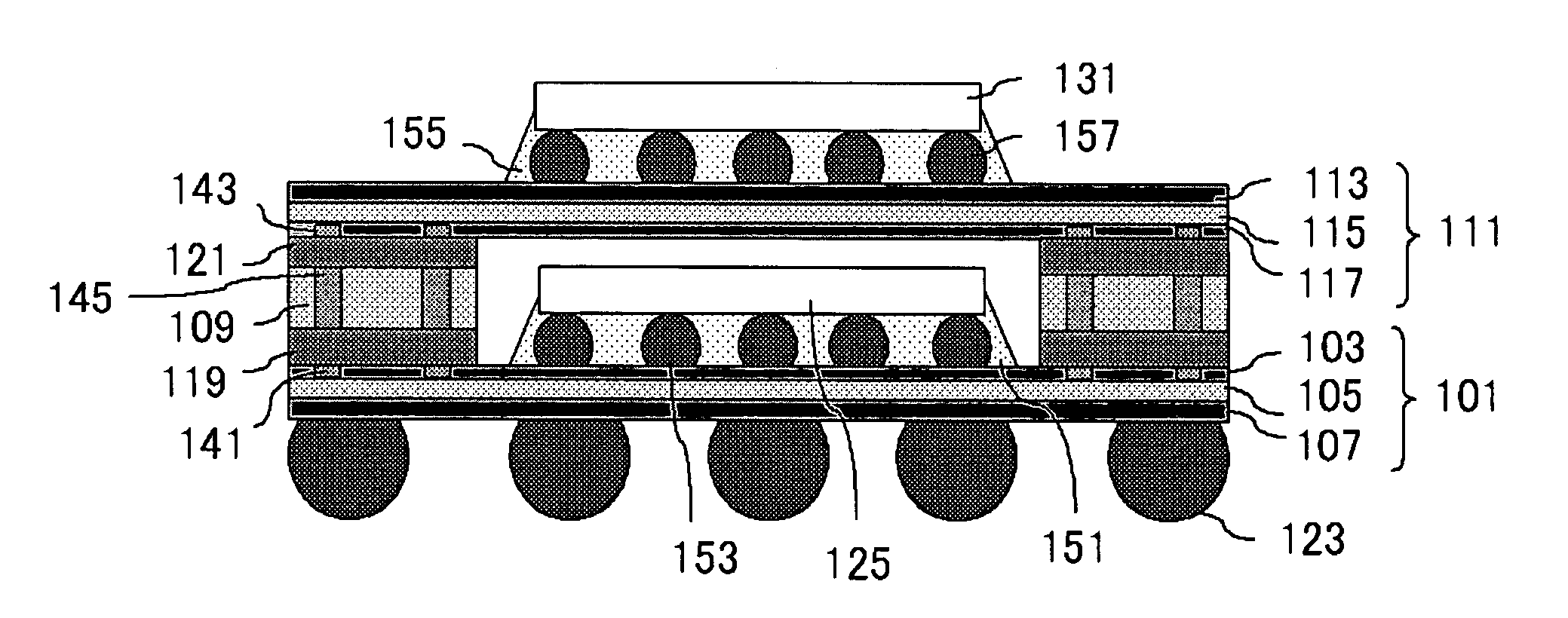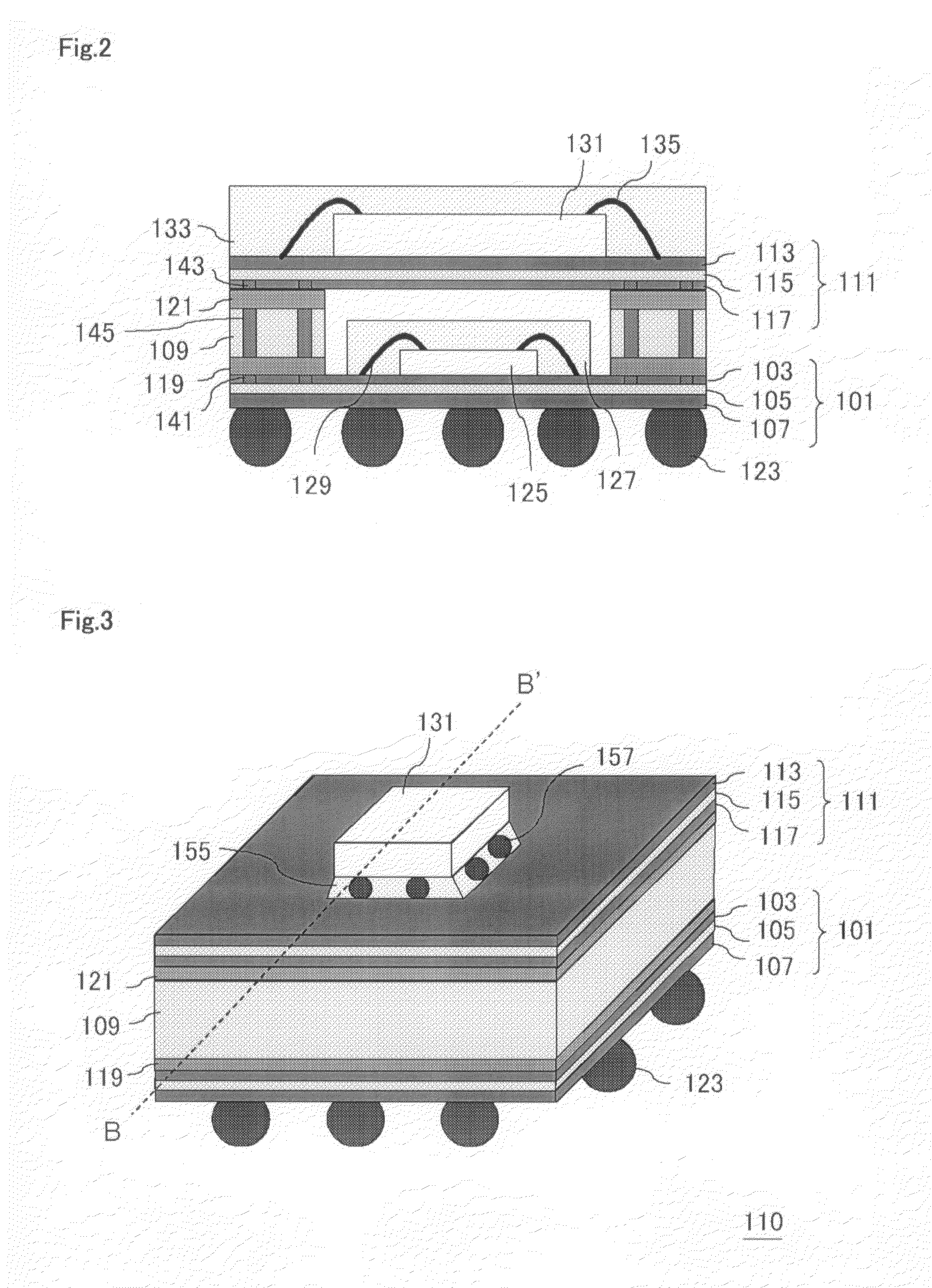Semiconductor device and method for manufacturing semiconductor device
a semiconductor and semiconductor technology, applied in the direction of semiconductor devices, semiconductor/solid-state device details, electrical apparatus, etc., can solve the problems of inhibiting a decrease in joint reliability, reducing the bending of the substrate, and insufficient coupling between the substrate and the electrode, so as to improve joint reliability, reduce elastic modulus, and enhance the effect of adhesiveness
- Summary
- Abstract
- Description
- Claims
- Application Information
AI Technical Summary
Benefits of technology
Problems solved by technology
Method used
Image
Examples
first embodiment
[0111]FIG. 1 is a perspective view, illustrating a configuration of a semiconductor device of the present embodiment. FIG. 2 is a cross-sectional view of FIG. 1 along line A-A′. In a semiconductor device 100 shown in FIG. 1 and FIG. 2, a first resin substrate 101, an adhesive layer 119, a resin spacer (resin base material 109), an adhesive layer 121 and a second resin substrate 111 are stacked in this sequence from underneath.
[0112]This semiconductor device 100 has a POP structure, and a first semiconductor chip 125 is mounted on a surface of the first resin substrate 101, and a second semiconductor chip 131 is mounted on a surface of the second resin substrate 111.
[0113]The first semiconductor chip 125 and the second semiconductor chip 131 are semiconductor chips, having certain elements such as transistor and the like formed on a device-forming surface of a semiconductor substrate such as silicon substrate and the like, respectively. The first semiconductor chip 125 may be configu...
second embodiment
[0152]While the configuration having the semiconductor chip wire-bonded onto the resin substrate has been illustrated in relation to the semiconductor device described in first embodiment, the semiconductor chip may be flip-connected to the resin substrate via the bump electrode. The present embodiment will describe such configuration.
[0153]FIG. 3 is a perspective view, illustrating a configuration of a semiconductor device in the present embodiment. FIG. 4 is a cross-sectional view along line B-B′ of FIG. 3. The fundamental configurations of semiconductor devices 110 shown in FIG. 3 and FIG. 4 are similar to that of the semiconductor device 100 (FIG. 1, FIG. 2), except that the method of mounting the semiconductor chip onto the resin substrate is different therefrom.
[0154]In the semiconductor device 110, an electrode (not shown) provided on the element mounting surface of the first semiconductor chip 125 is joined to the electrode (not shown) provided on the built-up 103 of the fir...
third embodiment
[0168]An embodiment of the present invention will be described as follows, on the basis of the annexed figures. First of all, an outline of a semiconductor device 1 according to the present embodiment will be described in reference to FIG. 12 to FIG. 17. The semiconductor device 1 includes, as shown in FIG. 12 and FIG. 13, a first resin substrate 3 on which a first semiconductor chip 2 is mounted, a second resin substrate 5 on which a second semiconductor chip 4 is mounted, and a resin spacer 6, which is in contact with a front surface of the first resin substrate 3 and a back surface of the second resin substrate 5, and provides an electrical juncture between the first resin substrate 3 and the second resin substrate 5. FIG. 13 is a cross-sectional view along II-II direction of FIG. 12. The resin spacer 6 is disposed in a circumference of the first semiconductor chip 2 on the front surface of the first resin substrate 3, and, on the front surface of the first resin substrate 3, the...
PUM
 Login to View More
Login to View More Abstract
Description
Claims
Application Information
 Login to View More
Login to View More - R&D
- Intellectual Property
- Life Sciences
- Materials
- Tech Scout
- Unparalleled Data Quality
- Higher Quality Content
- 60% Fewer Hallucinations
Browse by: Latest US Patents, China's latest patents, Technical Efficacy Thesaurus, Application Domain, Technology Topic, Popular Technical Reports.
© 2025 PatSnap. All rights reserved.Legal|Privacy policy|Modern Slavery Act Transparency Statement|Sitemap|About US| Contact US: help@patsnap.com



